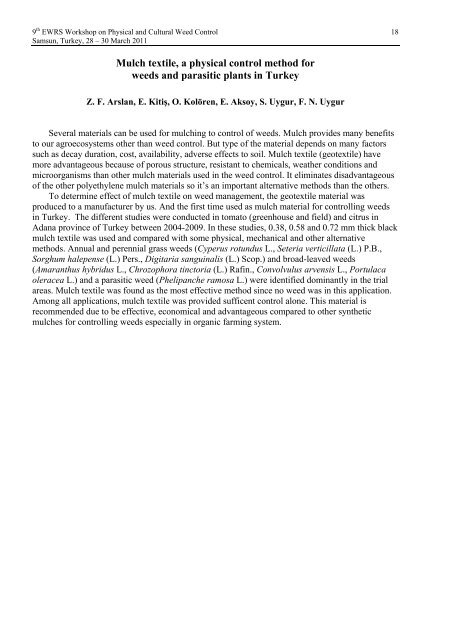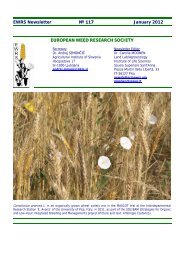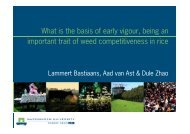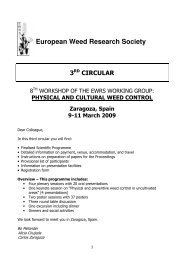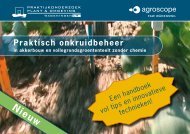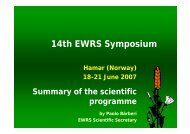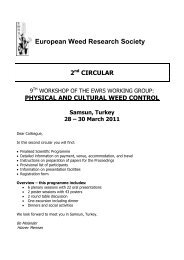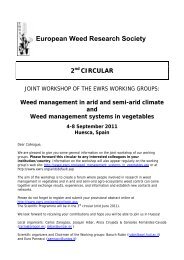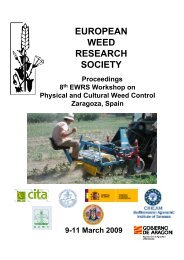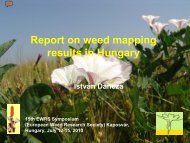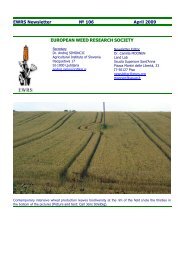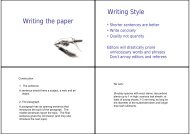Physical and Cultural Weed Control Working Group of - European ...
Physical and Cultural Weed Control Working Group of - European ...
Physical and Cultural Weed Control Working Group of - European ...
You also want an ePaper? Increase the reach of your titles
YUMPU automatically turns print PDFs into web optimized ePapers that Google loves.
9 th EWRS Workshop on <strong>Physical</strong> <strong>and</strong> <strong>Cultural</strong> <strong>Weed</strong> <strong>Control</strong> 18<br />
Samsun, Turkey, 28 – 30 March 2011<br />
Mulch textile, a physical control method for<br />
weeds <strong>and</strong> parasitic plants in Turkey<br />
Z. F. Arslan, E. Kitiş, O. Kolören, E. Aksoy, S. Uygur, F. N. Uygur<br />
Several materials can be used for mulching to control <strong>of</strong> weeds. Mulch provides many benefits<br />
to our agroecosystems other than weed control. But type <strong>of</strong> the material depends on many factors<br />
such as decay duration, cost, availability, adverse effects to soil. Mulch textile (geotextile) have<br />
more advantageous because <strong>of</strong> porous structure, resistant to chemicals, weather conditions <strong>and</strong><br />
microorganisms than other mulch materials used in the weed control. It eliminates disadvantageous<br />
<strong>of</strong> the other polyethylene mulch materials so it’s an important alternative methods than the others.<br />
To determine effect <strong>of</strong> mulch textile on weed management, the geotextile material was<br />
produced to a manufacturer by us. And the first time used as mulch material for controlling weeds<br />
in Turkey. The different studies were conducted in tomato (greenhouse <strong>and</strong> field) <strong>and</strong> citrus in<br />
Adana province <strong>of</strong> Turkey between 2004-2009. In these studies, 0.38, 0.58 <strong>and</strong> 0.72 mm thick black<br />
mulch textile was used <strong>and</strong> compared with some physical, mechanical <strong>and</strong> other alternative<br />
methods. Annual <strong>and</strong> perennial grass weeds (Cyperus rotundus L., Seteria verticillata (L.) P.B.,<br />
Sorghum halepense (L.) Pers., Digitaria sanguinalis (L.) Scop.) <strong>and</strong> broad-leaved weeds<br />
(Amaranthus hybridus L., Chrozophora tinctoria (L.) Rafin., Convolvulus arvensis L., Portulaca<br />
oleracea L.) <strong>and</strong> a parasitic weed (Phelipanche ramosa L.) were identified dominantly in the trial<br />
areas. Mulch textile was found as the most effective method since no weed was in this application.<br />
Among all applications, mulch textile was provided sufficent control alone. This material is<br />
recommended due to be effective, economical <strong>and</strong> advantageous compared to other synthetic<br />
mulches for controlling weeds especially in organic farming system.


